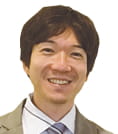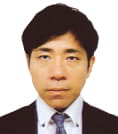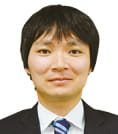- JST Home
- /
- Strategic Basic Research Programs
- /
 PRESTO
PRESTO- /
- project/
- Controlled Reaction by Electrons or Ions/
- [Controlled Reaction] Year Started : 2018
[Controlled Reaction] Year Started : 2018
Fumiaki Amano
Development of electrochemical reduction process for selective oxidation of hydrocarbons with oxygen
Researcher
Fumiaki Amano

Associate Professor
Faculty of Environmental Engineering
The University of Kitakyushu
Outline
The aim of this study is developing an energy-saving process for the production of value-added chemicals. We focus on an electrochemical method for selective oxidation of hydrocarbons with molecular oxygen, which has been difficult to control until now. Active oxygen species promoting oxygen atom insertion into hydrocarbons would be generated by electrochemical reduction of molecular oxygen. The electron donor should be water rather than hydrogen. This innovative reaction technology will be achieved by a combination of catalytic and electrochemical approaches with chemical engineering approach controlling mass transfer and separation.
Ken Albrecht
Active control of chemical reactions via electric field induced orbital deformation
Researcher
Ken Albrecht

Associate Professor
Institute for Materials Chemistry and Engineering
Kyushu University
Outline
Applying large external electric field to a molecule will result in the deformation of the molecular orbital. In this research, 1. The reactivity change of molecules through orbital deformation will be investigated, and 2. A method to apply a strong electric field to large number (mole scale) of molecules by utilizing nanogap electrodes will be developed. This will lead to establish a new methodology to actively control a chemical reaction with external electric field.
Shinsuke Inagi
Development of wireless electrolytic reaction systems driven by external electric fields
Researcher
Shinsuke Inagi

Associate Professor
School of Materials and Chemical Technology
Tokyo Institute of Technology
Outline
This research focuses on the development of environmentally friendly organic electrosynthetic systems based on split bipolar electrodes, where electricity can be monitored. Various organic electrosynthetic reactions are investigated in low concentration of supporting electrolytes, in addition to analytical and simulation studies.
Emiko Kazuma
Control of plasmon-induced chemical reaction by controlling molecular interfaces
Researcher
Emiko Kazuma

Research Scientist
Cluster for Pioneering Research
RIKEN
Outline
Localized surface plasmon (LSP) of metal nanostructures excited with light has been expected as a highly efficient way to convert light energy to chemical energy. This research obtains fundamental knowledge for the design of plasmonic catalysts providing efficient reaction pathways. The reaction pathways and mechanism of plasmon-induced chemical reactions are controlled by controlling the interface between molecules and metals. Furthermore, the control of the plasmon-induced reactions will be achieved on the basis of investigating the elementary process of the reactions at a single-molecule level.
Tatsuya Kameyama
Enhanced Photocatalytic Activity of Hetero-Nanoparticle via Quantum Cutting
Researcher
Tatsuya Kameyama

Associate Professor
Graduate School of Engineering
Nagoya University
Outline
Photocatalysis, which converts light energy into chemical energy in fuel, has been attracted much attention, and improvement of their reaction efficiency has been extensively studied. In this research, I will demonstrate the new photocatalytic reaction using quantum cutting process (multiple exciton generation) peculiar to quantum dots. By using photoelectrochemical cell, ultra-high efficiency reaction with external quantum efficiency exceeding 100% at high energy irradiation will be approached. This will be achieved by formation of hetero junction in single semiconductor nanoparticle, which will separate the multiple exciton generated in the photocatalysts via type-II electronic energy structure at the hetero-interface.
Masaaki Kitano
Development of ammonia synthesis catalysts activated by photoexcitation of hydride ions
Researcher
Masaaki Kitano

Associate Professor
Materials Research Center for Element Strategy
Tokyo Institute of Technology
Outline
The objective of this research is to develop a new ammonia synthesis catalyst that works under milder conditions than the conventional ammonia synthesis process. In this catalytic system, photoexcitation of hydride ions in hydride materials is a key step to realize N2 activation under mild conditions. I will develop the new catalyst containing hydride material and metal nanoparticles to lower the temperature and pressure of ammonia synthesis process.
Kosuke Suzuki
Creation of multielectron/proton transfer catalysts based on metal oxide clusters
Researcher
Kosuke Suzuki

Associate professor
Graduate School of Engineering
The University of Tokyo
Outline
In order to produce storable chemical energy and useful carbon resources by using visible light and/or electronic energy, this research develops novel metal oxide cluster capable of multi-electron/proton transfer reactions. Based on the design of catalysts showing new reactivity and selectivity, this research realized difficult oxidation/reduction reactions.
Yasufumi Takahashi
Development of nanoscale electrocehmical imaging techmique
Researcher
Yasufumi Takahashi

Professor
Nano Life Science Institute
Kanazawa University
Outline
I will develop four types of scanning probe microscopies for visualizing and understanding nanoscale electrochemical reaction of catalysts and electricity storage materials. By using these probe microscopies, I will visualize and control of local catalytic activity, understand of ion and hole conduction related chemical reactions, image ionic profile in solution, and develop the elemental technologies for local electrochemical measurement.
ATSUHIRO TANAKA
Development of electron transfer- and chemoselectivity- controllable plasmonic photocatalyst for substrate conversion reactions
Researcher
ATSUHIRO TANAKA

Lecturer
Faculty of Science and Engineering
Kindai University
Outline
Surface plasmon resonance of metal nanoparticles has been applied to photocatalyst under widely visible light. This study aims at the development and design of electron transfer-controllable plasmonic photocatalysts for substrate conversion reactions. In addition, the goal of this research is the improvement of substrate- and functional group-selectivity by control of electron transfer.
Kenji Hirai
Control of Chemical Reaction by Rabi Slitting
Researcher
Kenji Hirai

Associate Professor
Research Institute for Electronic Science
Hokkaido University
Outline
How chemical reactions are influenced by molecular vibration is a long-standing question across fundamental physics and chemistry. Coupling of molecular vibration with the optical modes of a microcavity generates new polaritonic states in the infrared region. This phenomenon will be planted into the field of chemical synthesis, resulting in development of a new methodology to manipulate chemical reactions.
Taniyuki Furuyama
Development and Control of Near-IR Light Promoted Reaction Processes
Researcher
Taniyuki Furuyama

Associate Professor
Graduate School of Natural Science and Technology
Kanazawa University
Outline
This project focuses on organic reaction processes with near-infrared (near-IR) light. Sunlight is a powerful and sustainable source for organic reaction processes, and visible light promoted organic reactions have been attracted in recent years. An absorption and excitation of a catalyst are required for proceeding the reaction. However, substrates absorbing in the visible light (visible light materials) can not apply to such reactions because both catalyst and substrate absorb the light simultaneously. To overcome this problem, catalysts absorbing near-IR light, which does not interact with visible light materials, are designed by the functionalization of azaporphyrin derivatives. This process may be a novel strategy for late-stage functionalization of visible light materials.













